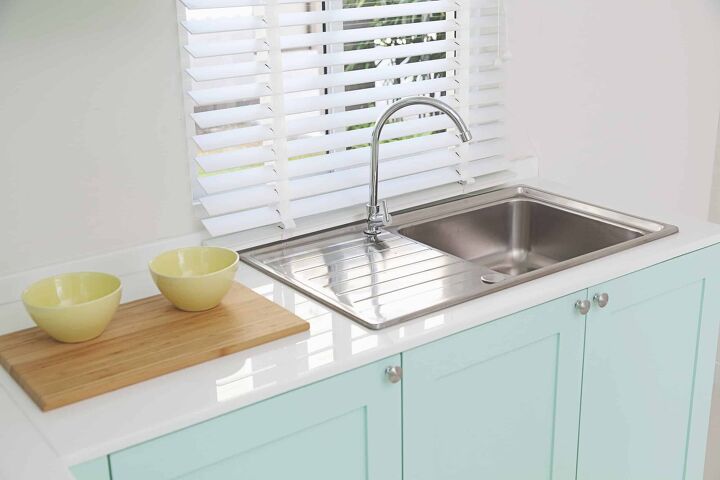36 Parts of a Kitchen Sink (with Diagram)

Although every sink is slightly unique, you’ll certainly find different components in a kitchen than you would a bathroom. Knowing all the inner workings of a kitchen sink can make troubleshooting and repairs a breeze.
From the parts that make up the faucet to all the pieces found underneath the countertop, there are many vital components involved. With that said, here is our comprehensive list of 36 parts of a kitchen sink.
Parts of a Kitchen Sink
1. Faucet
Put simply, the faucet is the part on a sink where the water comes out. It can be broken down into its individual components, including the aerator, lever, faucet body, spout assembly, spout, adjusting ring, mounting nut, washer, compression couplings, escutcheon, and spray hose.
2. Kitchen Faucet Aerator
Found at the tip of the spout, the aerator features a small mesh screen that’s positioned at the end of the faucet. Its purpose is to help regulate the flow of water into small streams.
3. Faucet Lever
The lever is what controls the water supply. The majority of kitchen sinks feature a single lever that is turned left or right, depending on the temperature of the water desired. However, some models may have separate controls – similar to a bathroom sink.
4. Faucet Body
The body of the faucet is where the hot and cold water are combined before they are released out of the spout. It is essentially the component that transports water into the basin from the plumbing system.
5. Spout Assembly
The spout assembly encompasses the spout body, handles, and cap. It is specifically designed to control the spout.
6. Adjusting Ring
Also referred to as the O-ring or gasket, the adjusting ring serves as a seal. It may be made out of rubber, metal, brass, or another material. Regardless, its purpose is to make sure that the joints of the faucet are impermeable. On single-handle faucets, it will also alter the pressure on the spout assembly.
7. Spout
The spout is the most noticeable component of the faucet, as it is what enables the water to flow through the body and into the sink.
8. Mounting Nut
The mounting nut’s purpose is to secure the faucet to the sink. This component is easy to install, provided that you have enough clearance between the sink and the wall.
9. Washer
The washer may be made of plastic, metal, or rubber and is used to connect the aerator to the body of the faucet.
10. Shut-off Valves
The shut-off valves are used to control the flow of water to the sink. Shutting them off is required in the case of a leak or if you are performing a repair.
11. Compression Couplings
The compression couplings allow you to link two plumbing lines or pipes to a fixture without the need to solder them together. They create clean connections in tight spaces and typically consist of a compression wring, a female-threaded cap, and a male-threaded seat.
12. Spray Hose
The spray hose is what connects the water supply to the faucet as a whole. It also connects the handheld sprayer to the water supply, if the specific sink is equipped with one.
13. Cartridge
Each lever in a faucet will have its own cartridge. The cartridge is a valve that turns with the lever to control the temperature and flow of water into the spout. They typically use an up and down motion to regulate water flow and a left to right motion to control temperature.
14. Spray Head
The spray head itself is a detachable feature included on many, but not all, kitchen sinks that makes washing dishes much easier. They typically share the same water supply lines as the faucet, via a connecting spray hose. In most setups, you can either use the spray head or the faucet, but you cannot use both at the same time.
15. Hose Guide
The hose guide is, as the name suggests, used for guiding the hose to allow for easy watering with the sprayer It also helps to prevent the hose from getting caught during operation and protects against scraping.
16. Hot Water Supply
This system supplies hot water from the source to the faucet. Furthermore, the hot water line usually comes from a water heater in the home, which you can set to the desired temperature.
17. Cold Water Supply
This system allows the cold water to be delivered directly from the cold water line to the kitchen sink. According to building code regulations, the cold water supply must be installed on the right side of the kitchen sink.
18. Escutcheon
The escutcheon is the part that attaches the sink to either the kitchen faucet or the kitchen lever. It is a flat piece of metal that sits on top of the holes that connect the supply lines and coupling compressor. Depending on its design, it can also be seen as a decorative element to the sink.
19. Basin
A kitchen sink basin refers to the container that retains the water from the faucet before it empties down into the drain. This is the primary component of the sink and the place where dishwashing and hand washing is done. Basins may be located on a pedestal, a countertop, or even mounted on the wall.
20. Dishwasher Drain Hose
The dishwasher drain hose’s purpose is to remove dirty water from the dishwasher. This component is easily recognizable because it usually has a loop at the top that prevents dirty water from flowing into your sink.
21. Garbage Disposal
The garbage disposal is the unit installed underneath the sink between the P-trap and the drain. It is designed to grind up food residue and wash it away, preventing clogs.
22. Stopper
Stoppers in kitchen sinks are specially designed to help collect food waste before it escapes down the drain. Though, sink stoppers are not permanent fixtures, meaning you can use the garbage disposal as needed. They are also used to stop the water from going down the drain when you need to fill up the basin.
23. Strainer
The strainer is actually a system, consisting of multiple pieces, that works to filter debris out of the sink. Strainer systems usually involve a strainer body, flange, basket, and a coupling. Additionally, the strainer is connected to the drain pipe.
24. Strainer Basket
The strainer basket is a slotted component placed at the bottom of the basin to allow water to filter down the drain, but catch any debris. It is designed to keep food and other solids out of your pipes.
25. Strainer Flange
The flange is a metal piece that sits right below the strainer basket. When applicable, it connects to your garbage disposal.
26. P-Trap
This essential component of your kitchen sink consists of two pipes and is designed to remove waste and water from the sink. The two pipes form a pronounced U-shape, which prevents clogs.
27. Cleanout
Positioned at the lowest point of the curve on the P-trap, the cleanout is a pipe fitting that lets you remove debris and clogs from the trap.
28. Locknut
Typically made out of a soft metal, locknuts are designed to create a solid seal between the drain basket and the underside of the sink.
29. Supply Tube
A supply tube is a flexible tubing that connects the water supply to the faucet.
30. Sink Drain
All sinks – whether it’s in the kitchen or the bathroom – have a drain that allows the water from the faucet to escape from the sink basin. The drain is connected to the drain pipe and the P-trap, along with the plumbing connection hidden in your walls.
31. Tailpiece
Directly below the sink basin, and connected to the drain, is the tailpiece. This is a long, vertical piece of pipe that attaches to the P-trap.
32. Rubber Gasket
Rubber gaskets provide a protective barrier between joints. It is primarily used to create a watertight seal in between kitchen sink pipe joints.
33.Friction Gasket
The purpose of the friction gasket is to allow the strainer nut to slide easily past the rubber gasket as the nut is tightened. The strainer nut, rubber gasket, and friction gasket all work together to create a watertight seal between the strainer flange and P-trap.
34. Drain Pipe
The drain pipe is the last section of pipe on a kitchen sink drain. It may be angled horizontally to the main drain, or a vertical pipe that goes through your floor and attaches to the main drain pipe. In most cases, the main drain is a metal pipe with coarse threading, so that it connects to the drain pipe.
The purpose of the drain pipe is to transport the dirty water from the sink out of your home. Though, it also helps regulate air pressure in the water pipes to prevent air clogs.
35. Countertop
The countertop refers to the flat working area surface that surrounds the sink in the kitchen. They come in a wide array of materials including marble, granite, and tile.
36. Waste Arm
The waste arm is the component that extends out from the kitchen sink’s P-trap. It is attached to the end of the trap with a nut and washer, while the other end of the waste arm connects to the main drain.

Jessica considers herself a home improvement and design enthusiast. She grew up surrounded by constant home improvement projects and owes most of what she knows to helping her dad renovate her childhood home. Being a Los Angeles resident, Jessica spends a lot of her time looking for her next DIY project and sharing her love for home design.
More by Jessica Stone


















![Finishing Basement Without Permit [Is It Really Illegal?]](https://cdn-fastly.upgradedhome.com/media/2023/07/31/9070078/finishing-basement-without-permit-is-it-really-illegal.jpg?size=350x220)



![Standard Dining Room Table Dimensions [for 4, 6, 8, 10 and 12 People]](https://cdn-fastly.upgradedhome.com/media/2023/07/31/9074335/standard-dining-room-table-dimensions-for-4-6-8-10-and-12-people.jpg?size=350x220)



![12 Washing Machine Brands to Avoid [with Recall Data]](https://cdn-fastly.upgradedhome.com/media/2023/07/31/9075781/12-washing-machine-brands-to-avoid-with-recall-data.jpg?size=350x220)





